Trigma is a leading IT service provider and consulting company, enabling businesses to devise and execute their modernization strategy to improve their IT structure and efficiency. We are an established provider of services like Custom Software Development, Web and Mobile Application Development, Cloud Migration, and Software Maintenance.
Don't wanna be here? Send us removal request.
Text
Building an Online Rental Marketplace App with No-Code Expertise: Choose Trigma and Bubble.io
In the bustling domain of digital commerce, online rental marketplaces have carved out a significant niche. But how can businesses venture into this sector without diving deep into the complexities of coding? The answer lies in no-code development platforms, and more specifically, in Bubble.io. Trigma, a distinguished software development company, brings a wealth of expertise to the table, helping businesses craft their online rental marketplace vision using Bubble.io.
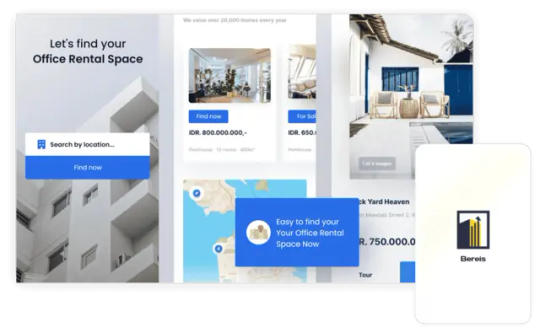
Why No-Code Platforms are Revolutionizing the Rental Platform Development

Ease of Use: With no coding knowledge required, platforms like Bubble.io have democratized the app development process. Anyone can bring their ideas to life.
Cost-Effective: Traditional app development can be expensive. No-code solutions offer a more budget-friendly alternative.
Quick Turnaround: Build and launch your rental marketplace app in a fraction of the time it would take using traditional methods.
Why Trigma is Your Best Bet for No-Code Rental Platform Development
Proven Expertise: Trigma's portfolio showcases a range of projects that have benefited from our deep-rooted understanding of no-code platforms like Bubble.io.
Tailored Solutions: Every online rental marketplace has unique requirements. Trigma ensures your platform is customized to match your business goals.
Time-Efficient Delivery: In the agile world of startups and businesses, Trigma prioritizes swift development without compromising on quality.
Seamless Integration: Whether it's payment gateways or user management systems, Trigma ensures all integrations are smooth and efficient.
Conclusion
Building a robust online rental marketplace doesn't require coding gymnastics. With Trigma's proficiency in Bubble.io, you're opting for a streamlined, efficient, and customized development process. Whether you're looking to build from scratch or refine an existing platform, trust Trigma to bring your vision to life.
2 notes
·
View notes
Text
Unleashing Your Startup's Potential: The Power of MVP Development
Leveraging MVP (Minimum Viable Product) development is a game-changer for startups aiming to expedite their business growth. It is an efficient and cost-effective approach where a new product is developed with sufficient features to satisfy early adopters. MVP development focuses on core functionalities, enabling startups to quickly launch their product to the market, gather valuable user feedback, and iterate based on real-world insights. This lean methodology reduces risks and investment, ensuring the product aligns with consumer needs before committing to full-scale production. Thus, MVP development is a powerful tool for startups to validate their business ideas, optimize product-market fit, and accelerate their trajectory towards business growth.
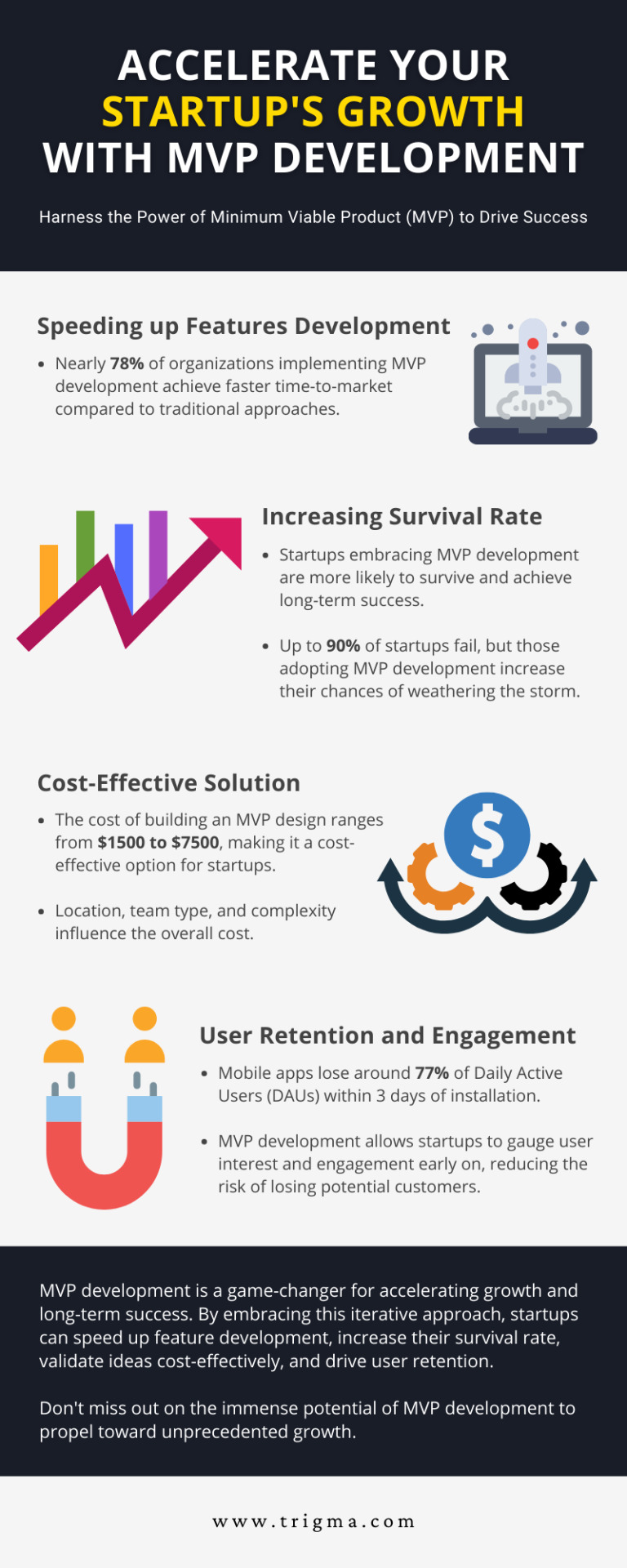
The Power of MVP Development: Accelerating Startup Growth through Iteration and Validation
Notable companies have demonstrated the power of MVP development by starting small, learning from their user base, and continuously iterating. For instance, Dropbox started as a simple demo video explaining its concept. The overwhelming positive response gave the founders confidence to build the full product, eventually becoming a leader in cloud storage.
Similarly, the social media giant Facebook started as an MVP called 'Thefacebook', initially available only to Harvard students. Based on user feedback and acceptance, it gradually expanded to other universities, before becoming the global platform it is today.
Uber also began as an MVP, initially offering only black luxury cars in San Francisco. As the concept of ride-hailing gained acceptance, Uber broadened its services, ultimately disrupting the global transportation industry.
In each example, MVP development allowed these startups to validate their ideas and refine their products based on real-world feedback before expanding their offerings. These success stories underline the potential of MVP development in accelerating startup growth.
Benefits of MVP Development for Startups
Implementing MVP development in a startup's growth strategy presents numerous advantages.
Firstly, cost-efficiency; building an MVP requires less capital compared to full-fledged product development, making it a financially prudent decision for startups.
Secondly, it enables fast market entry; the development period for an MVP is significantly shorter, allowing startups to launch their product quickly and gain a competitive edge.
Thirdly, MVPs facilitate risk mitigation; by testing the product in the market at an early stage, startups can identify potential issues and rectify them before investing in full-scale production.
Lastly, MVP development fosters user-driven product evolution; startups can use the feedback from the MVP to refine their product, ensuring it meets the customers' needs and expectations. In essence, MVP development empowers startups to build products that are more likely to succeed in the market.
Also read: 9 Benefits of an MVP in Software Development
MVP development is a powerful tool that enables startups to quickly enter the market, efficiently use resources, and produce a product that resonates with the consumer. Instead of spending time and resources on potentially unproven concepts, MVPs allow startups to validate their product idea with real-world feedback and adapt accordingly. The success stories of world-renowned companies like Facebook, Airbnb, and Uber underline the potential of this approach. With MVP development, startups have a concrete, data-driven foundation to scale their business and accelerate their growth trajectory. By focusing on the essential features, gathering user feedback, iteratively refining the product, and persistently pursuing innovation, startups can significantly enhance their chances of success in the competitive business landscape.
You may also like:
MVP Development vs. Full-Scale Product Development
0 notes
Text
Cloud App Development: Why Not Implementing Autoscaling Is a Big Mistake
In the aspect of cloud-based application development, staying competitive requires more than just deploying your application to the cloud. It demands a thorough understanding of how to harness the full potential of cloud resources while optimizing costs and performance. One key aspect often overlooked is autoscaling.

In this blog, we'll explore why not implementing autoscaling can be a significant mistake in cloud-based application development and how cloud consulting and custom cloud application development can help you avoid this pitfall.
The Importance of Scalability in Cloud-Based Application Development
Scalability is a fundamental requirement for modern cloud-based applications. It's the ability to handle varying workloads efficiently without manual intervention, ensuring a seamless user experience during both normal and peak usage periods. Traditionally, scaling involved provisioning more resources upfront to accommodate expected loads, resulting in idle resources during periods of low activity.
The Downside of Manual Scaling
Before diving into the specifics of autoscaling, let's discuss the drawbacks of manual scaling, which was common in the pre-cloud era and is still practiced by some developers in the cloud:
Inefficiency: Manual scaling often leads to underutilized resources during low-traffic periods and potential resource shortages during unexpected spikes.
Increased Costs: Over-provisioning to handle peak loads can significantly increase cloud infrastructure costs, eroding potential cost savings.
Operational Complexity: Continuously monitoring and adjusting resources manually can be time-consuming and error-prone.
Limited Responsiveness: Manual scaling struggles to react quickly to sudden traffic surges, potentially resulting in service interruptions or poor performance.
Autoscaling: A Solution Tailored for the Cloud
Autoscaling addresses these issues by automatically adjusting the number of compute resources based on real-time traffic and application demands. It optimizes resource allocation, ensuring that you only pay for what you use while maintaining consistent performance. Autoscaling in cloud-based application development offers several key advantages:

Cost Optimization: Autoscaling ensures you're not paying for idle resources, resulting in significant cost savings over manual scaling.
Improved Performance: The ability to add or remove resources dynamically ensures that your application can handle varying loads while maintaining optimal performance.
Enhanced Reliability: Autoscaling can help maintain service availability by quickly responding to increased demand and mitigating potential resource shortages.
Simplified Operations: With autoscaling, much of the resource management is automated, reducing the operational burden on your development and operations teams.
The Role of Cloud Consulting
Implementing autoscaling effectively requires a deep understanding of cloud services, application architecture, and performance monitoring. This is where cloud consulting comes into play. Cloud consultants are experts in cloud technologies who can assess your specific needs and design a customized autoscaling strategy for your cloud-based application.

Custom Cloud Application Development with Autoscaling
Integrating autoscaling should be a fundamental part of the development process when building custom cloud-based applications. Cloud application developers should consider the following steps:
Design for Scalability: Develop your application with scalability in mind, making it easier to adapt to changing workloads.
Select the Right Metrics: Choose the right performance metrics to trigger autoscaling actions based on your application's requirements.
Define Scaling Policies: Establish clear rules for scaling actions, such as adding or removing instances based on traffic thresholds.
Continuous Monitoring: Implement robust monitoring and alerting systems to track application performance and trigger autoscaling as needed.
Regular Testing: Test your autoscaling configurations under various traffic conditions to ensure they respond effectively.
Optimize Costs: Implement cost optimization strategies alongside autoscaling to ensure you get the most value from your cloud resources.
Conclusion
In the world of cloud-based application development, implementing autoscaling is a mistake that can lead to efficient resource utilization, increased costs, and operational challenges. To avoid this pitfall, consider leveraging the expertise of cloud consulting services and incorporating autoscaling as a core component of your custom cloud application development strategy. By doing so, you'll ensure that your applications can adapt and thrive in the dynamic landscape of the cloud.
0 notes
Text
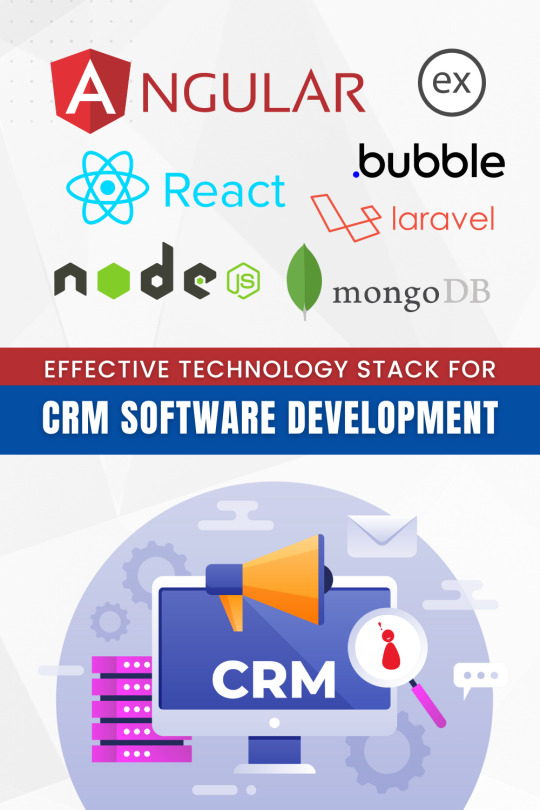
Stay ahead with Trigma's CRM software development services. Discover why MEAN/MERN, Laravel, and Bubble are preferred for crafting cutting-edge CRM.
0 notes
Text
Discover the power of CRM software development services with Trigma. Streamline processes, retain customers & drive sales growth. Get insights on when to adopt a CRM, the tech stack Trigma uses for CRM development, and the evolution of CRM systems.
#CRM#crm software#crm development#crm consulting#crm services#crm software development#mongodb#angular js#reactjs#nodejs#laravel
0 notes
Text
SaaS Development: Building Cloud-Based SaaS Applications and Services
Software as a Service (SaaS) has transformed the software industry, offering businesses and individuals a flexible and cost-effective way to access and utilize software applications. SaaS development involves creating cloud-based applications that are hosted on remote servers and made available to users over the Internet. This model eliminates the need for users to install and maintain software locally, streamlining the process and reducing operational overhead. Building a SaaS involves several key steps that ensure the development of a reliable and scalable solution.
Understanding SaaS Development
SaaS development entails crafting applications that are centrally hosted on cloud infrastructure and accessible via web browsers. This contrasts with traditional software development, where applications are installed on individual devices. The cloud-based nature of SaaS brings numerous advantages, such as easy accessibility, automatic updates, and seamless scalability.

Key Steps to Build a SaaS
1. Idea and Conceptualization

Every successful SaaS application starts with a clear idea. Identify a problem that the application can solve or a need it can fulfill. Define your target audience, understand their pain points, and conceptualize how your SaaS will address them. In the process of building a Software as a Service (SaaS) application, meticulous planning and thoughtful architecture are paramount.
During this critical step, developers define the technology stack, design the user interface, and structure the application's components. Proper planning ensures that the SaaS solution aligns with the target audience's needs, while a well-considered architecture sets the stage for scalability, security, and efficient development throughout the project lifecycle.
2. Market Research

Research the competitive landscape and market demand to ensure your SaaS idea is viable. Identify similar solutions, analyze their strengths and weaknesses, and find a unique value proposition that separates your SaaS. Market research plays a pivotal role in SaaS development. Developers can fine-tune their ideas and strategies by analyzing the competitive landscape and understanding user needs.
This step helps identify gaps in existing solutions and shape a unique value proposition. Comprehensive market research ensures that the SaaS application is aligned with market demands, leading to a product that resonates with users and gains a competitive edge in the industry.
3. Planning and Architecture

Outline the architecture of your SaaS application. Decide on the technology stack, including programming languages, frameworks, and databases. Plan the user interface (UI) and user experience (UX) design for optimal usability. Planning and architecture form the bedrock of SaaS creation. Detailed planning involves defining the project scope, goals, and resources.
Architecture sets the technical framework, selects technologies, and designs the application's structure. Both ensure that the SaaS aligns with user needs, streamlines development, and supports scalability. A well-structured foundation allows for efficient coding, reduces future complexities, and paves the way for a successful SaaS product.
4. Development

Begin the actual development process. Divide the development into manageable iterations or sprints. Develop the core features of your SaaS application, focusing on functionality, security, and performance. Development is where SaaS concepts materialize into functional reality.
During this phase, coding, testing, and refining take center stage. Core features are coded meticulously, ensuring they align with the planned architecture. Rigorous testing identifies and rectifies issues, resulting in a robust and reliable application. Development is the pivotal stage where ideas transform into user-facing functionality, marking a significant stride toward completing a valuable and innovative SaaS solution.
5. Cloud Infrastructure

Choose a reliable cloud provider such as Amazon Web Services (AWS), Microsoft Azure, or Google Cloud Platform (GCP). Set up the necessary infrastructure to host your application, manage databases, and ensure scalability. Selecting the right cloud infrastructure is pivotal in SaaS development.
This step ensures the application's accessibility, scalability, and reliability, enabling it to adapt seamlessly to user demands. Leveraging cloud infrastructure optimizes performance, simplifies management, and allows developers to focus on enhancing the user experience rather than grappling with hardware concerns.
6. Multi-Tenancy Architecture

Implement a multi-tenancy architecture, a fundamental aspect of SaaS. This architecture allows a single application instance to serve multiple customers (tenants) securely and efficiently. Implementing a multi-tenancy architecture is fundamental to SaaS development. This approach enables a single application instance to serve multiple users or tenants securely and efficiently.
It streamlines resource utilization, reduces costs, and simplifies maintenance. By segregating data and providing customized experiences within a shared environment, the multi-tenancy architecture ensures scalability and optimized performance, which is essential for any SaaS solution's success.
7. Testing and Quality Assurance

Rigorously test your SaaS application to identify and rectify bugs, glitches, and vulnerabilities. Perform unit, integration, and user acceptance testing to ensure a robust product.
8. Deployment and Scalability

Deploy your SaaS application on the chosen cloud infrastructure. Ensure that the deployment process is automated and can be replicated easily. Implement auto-scaling to handle increased user loads efficiently. Deploying a SaaS application onto a chosen cloud infrastructure is a crucial step. This ensures the solution is accessible to users.
Implementing scalability mechanisms is equally vital, allowing the application to accommodate growing user demands. Developers can effectively manage increased workloads by automating deployment processes and enabling dynamic resource allocation. This step ensures that the SaaS remains responsive, reliable, and capable of handling varying usage levels.
9. Monitoring and Maintenance
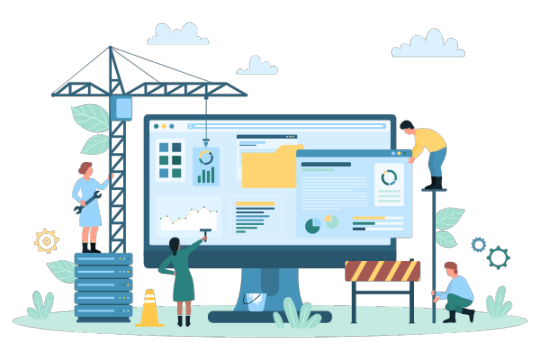
Set up monitoring tools to track the performance and health of your SaaS application. Proactively address any issues that arise and regularly release updates to introduce new features and improvements. Post-launch, continuous monitoring and maintenance are essential.
Monitoring tools track performance, detect anomalies, and provide insights into user behavior. Regular maintenance involves addressing issues promptly, releasing updates, and optimizing functionality. Proactive upkeep ensures the SaaS remains secure, efficient, and user-friendly. By staying vigilant and responsive, developers guarantee a seamless user experience and uphold the reliability of the SaaS application over its lifecycle.
10. User Feedback and Iteration

Once your SaaS is live, gather feedback from users. Use this feedback to make iterative improvements to your application, enhancing its functionality and addressing user needs.
11. Customer Support and Services

Provide excellent customer support to assist users with any issues they encounter. Consider offering various subscription tiers with different levels of support and services. Exceptional customer support and services are pivotal in SaaS development. Offering responsive assistance and guidance to users builds trust and fosters a positive user experience.
Providing different levels of support, from basic to premium, ensures that users receive the assistance they need. Addressing queries promptly and resolving issues enhances user satisfaction, promotes loyalty, and contributes to the long-term success of the SaaS application.
12. Continuous Innovation

To remain competitive, continuously innovate your SaaS application. Stay updated with industry trends, incorporate new technologies, and evolve your features to meet changing user requirements. Continuous innovation is a cornerstone of successful SaaS development in the ever-evolving tech landscape. After the initial launch, regularly introducing new features, enhancements, and improvements keeps the application relevant and enticing to users.
Staying attuned to market trends, user feedback, and emerging technologies allows developers to adapt swiftly, offering value that resonates with users and maintains a competitive edge in a dynamic market.
SaaS Development Services
SaaS development services offer a solution for businesses looking to build SaaS applications but lacking in-house expertise. These services provide specialized teams with experience in SaaS architecture, development, and deployment. They guide businesses through every stage of SaaS development, from initial ideation to ongoing maintenance.
Conclusion
In conclusion, SaaS development involves creating cloud-based applications accessible over the internet, offering users a convenient and scalable solution. To build a successful SaaS application, thorough planning, proper architecture, security measures, and a customer-centric approach are essential. Leveraging cloud infrastructure, adhering to best practices, and prioritizing user feedback is key to creating a compelling SaaS product. For those seeking assistance, SaaS development services can provide expertise and support throughout the entire development lifecycle.
Embracing SaaS as a software delivery model presents significant opportunities for innovation and growth in today's technology-driven landscape.
#saas#saas development#saas app development#app development#software development#software#software as a service#web portal development#company portal#company portal development
1 note
·
View note
Text
Overcoming Startup Challenges: Key Reasons for Failure and How Trigma Can Help

Startups are the lifeblood of innovation, transforming unique ideas into practical solutions. However, not all startups navigate the path to success, with many facing overwhelming challenges. The top reasons why startups fail can be attributed to several factors.
One of the primary reasons startups fail is running out of funds, which is the case for 47% of them. It's crucial for startups to manage their budgets meticulously, focusing on expenses that contribute directly to growth.
Secondly, 35% had no market need. Startups that rely on assumptions rather than validated data run the risk of creating products or services that don't resonate with customers. It's essential for startups to conduct thorough market research and validate their ideas before launching.
Thirdly, a flawed business model is another significant pitfall, with 15% of startups succumbing to this issue. The startup might struggle to achieve profitability if the revenue streams are unclear, unreliable, or unsustainable in the long term.
Lastly, pricing issues contribute to 19% of startup failures. The business might struggle if a startup's pricing doesn't accurately reflect the value the product or service provides to customers. It's vital to find a balance where the price is attractive to customers yet also sustainable for the business.
At Trigma, we understand the unique challenges startups face, as outlined above, and we're committed to helping you overcome them. Offering comprehensive IT solutions tailored specifically for startups, we strive to eliminate the technological hurdles that can impede growth. Our services include strategic IT consulting, the development of scalable software solutions, and reliable tech support, all designed to allow your startup to focus on what truly matters - innovation and growth. By combining our technical expertise with a deep understanding of the startup ecosystem, we help you avoid common pitfalls such as flawed business models or misaligned market needs. With Trigma by your side, transform your unique ideas into practical, profitable solutions that resonate with your target market.
0 notes
Text
How MVPs Help Developers Understand User Needs
In the dynamic landscape of MVP in software development, the success of a product hinges on its ability to meet the needs and expectations of its users. However, understanding those needs accurately can be a challenge. Enter the Minimum Viable Product (MVP) – a concept that has proven to be a game-changer for developers seeking to gain insights into user requirements. In this article, we will delve into how MVPs play a pivotal role in helping developers truly comprehend user needs.
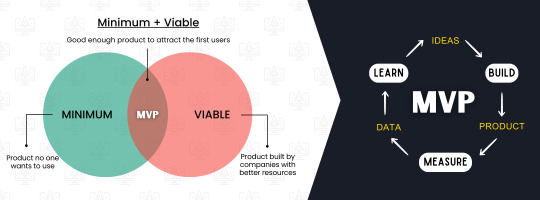
1. Starting with the Basics: What is an MVP?
A Minimum Viable Product is the simplest version of a product that contains only the core features necessary to address the most pressing user needs. It allows developers to get a functional version of the software into the hands of users quickly, collecting valuable feedback and data for iterative improvements.
2. Early User Engagement
MVPs initiate user engagement much earlier in the development process than traditional approaches. This early involvement in MVP app development ensures that developers can gather user opinions, suggestions, and pain points right from the start. By interacting with the product early on, users provide insights that shape the product's direction, features, and overall experience.
3. Real-world Testing and Validation
Developers might have an idea of how users will interact with their product, but assumptions can be vastly different from reality. Build MVP app to facilitate real-world testing, enabling developers to observe how users actually use.j the product. This information is invaluable for refining the product's design, functionality, and user interface.
4. Prioritizing Features
Based on User Value, MVPs force developers to identify and prioritize the most critical features that directly address user needs. This contrasts with trying to include every conceivable feature, which can lead to feature bloat and decreased user satisfaction. By focusing on the essentials, developers ensure that the product remains streamlined and efficient.
5. Rapid Iterations and Feedback Loop
One of the key advantages of building an MVP for startups is the iterative development process they foster. Developers can release successive versions of the product, each building upon the last based on user feedback. This continuous feedback loop allows for quicker adjustments, reducing the chances of building a product that misses the mark.
6. Adapting to Evolving User Needs
User needs and preferences can evolve over time, especially in fast-paced industries like technology. MVPs provide a means to adapt to these changes quickly. By consistently engaging with users and releasing updates, developers can pivot the product's direction to stay aligned with shifting demands.
7. Data-Driven Decision Making
MVPs generate a wealth of user data that developers can analyze to gain deep insights into user behavior and preferences. This data informs decisions regarding feature enhancements, user interface adjustments, and overall product strategy. Data-backed decisions increase the likelihood of success by ensuring that changes are well-informed and tailored to user needs.
8. Building Empathy for Users
Developers who directly engage with users through MVP releases gain a deeper understanding of their pain points, frustrations, and needs. This firsthand experience fosters empathy and a user-centric mindset, which is crucial for building products that resonate with the target audience.
Conclusion
In conclusion, MVP app development serves as a bridge between developers and users, facilitating meaningful interactions and insights. By allowing developers to release a basic version of their product and iteratively improve it based on user feedback, MVPs provide an unparalleled opportunity to truly understand user needs. This understanding leads to products that are not just functional but deeply resonate with users, setting the stage for success in today's competitive software development landscape.
#MVP#MVP App Development#Minimum Viable Product#Software Development#App Development for Startups#MVP Development for Startups
0 notes
Text
Why Choose Flutter for Your Next Mobile App Development Project?
Mobile apps have become a ubiquitous part of everyday life, and businesses are now embracing mobile app development as a way of getting ahead of the competition. A mobile app is the perfect way of engaging customers, enhancing brand recognition, and making a profit from your business. However, with so many choices out there, it can be difficult to know which platform to choose. Flutter, an exciting new option that is rapidly growing in popularity, is one such platform. And who better to assist you in leveraging this platform than Trigma, a leading provider of mobile app development services.

Cross-platform app development made easy
One of the most significant benefits of Flutter is that it allows for efficient cross-platform app development. That means that with Flutter, you can build an app that works on both Android and iOS, saving you time and resources. This is especially valuable for mobile app development companies like Trigma, as it opens up new avenues for increasing profit margins. With Flutter and Trigma’s expertise, you can now develop a single app that works on multiple platforms, streamlining the development process and making it easier to deploy.
Faster development and reduced costs
Time is a precious commodity, particularly in the tech world. One significant advantage of Flutter is that it speeds up the development process. The feature "hot reload" is a game-changer; you can see changes to your code live in your running app, meaning less time spent building and more time spent getting your app to market. Additionally, with Trigma’s efficient use of Flutter's platform-independent performance, you can optimize for power-hungry mobile applications, reducing the need to invest in expensive hardware. Overall, Flutter lowers the cost of development, which is music to any employer's ears.
User Interface
Flutter is also great for UI-centric applications. Its user-friendly interface allows developers to create engaging mobile apps with smooth animations and user-friendly interfaces. Flutter's widgets provide outstanding consistency in design and fast rendering performance. UI is crucial in mobile app development, as the better the UI, the more likely users are to keep using your app and sharing it with their friends and family. With Trigma's experience and Flutter's approach to UI design, you can offer users an exceptional experience.
Built-in tools and plugins
Finally, Flutter's built-in tools and plugins make life easier for developers. Flutter offers a wide range of plugins through its online library, allowing developers to integrate features like maps, in-app purchases, and video players with no trouble. With Flutter, developers can also implement push notifications, social media integration, and other features that are essential for app development, making the development process less daunting. Trigma’s mastery of these tools and plugins ensures that your app development process is seamless.
Conclusion
Flutter has disrupted the mobile app development world with its sophisticated features, excellent performance and, above all, its ability to develop cross-platform apps easily and efficiently. Flutter has the power to reduce development time and costs, improve UI and speed up development. These features make Flutter the ideal solution for mobile app development companies and individuals, providing them with the tools they need to create user-friendly and exciting mobile apps. Now that you know the benefits of using Flutter, you can gain a competitive edge for your business by leveraging its capabilities along with Trigma's expert services. Flutter is undoubtedly the future of mobile app development, and with Trigma, you'll be ready to take full advantage of it.
Ready to get started with your next app development project? Contact Trigma today to find out how we can help you leverage the power of Flutter!
#trigma#flutter#mobile app development#cross platform app development#mobile app development services#app development
0 notes
Text
The Power of No-Code App Development with Trigma
In the ever-evolving world of technology, businesses are constantly seeking ways to stay ahead of the curve. One such way is through app development. However, traditional app development can be time-consuming and expensive. This is where no-code app development comes into play, and at Trigma, we're leveraging this approach to help businesses transform their ideas into reality.
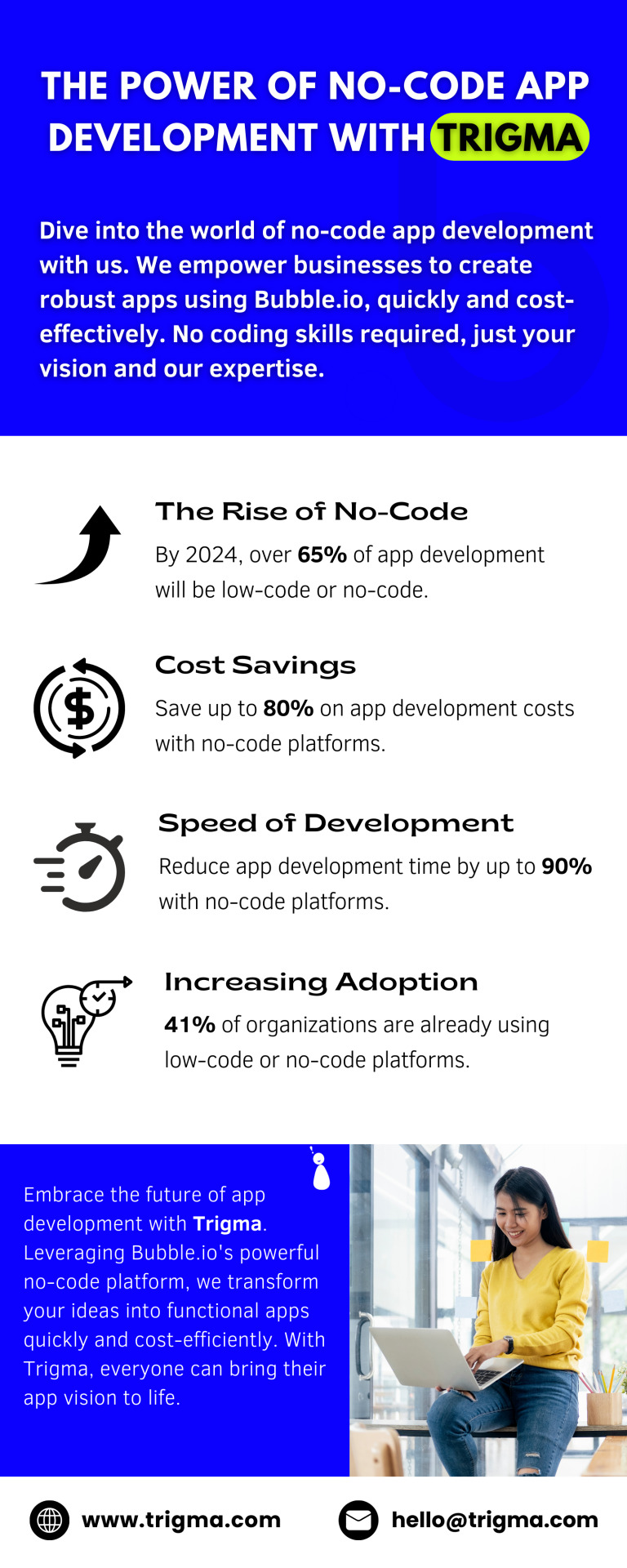
What is No-Code App Development?
No-code app development refers to the design and creation of applications using a visual development environment, like Bubble.io. Instead of writing lines of complex code, developers use drag-and-drop components and model-driven logic through a graphic interface. This approach allows for rapid development and deployment of apps, making it an attractive option for businesses looking to innovate quickly.
Trigma and No-Code App Development
At Trigma, we've embraced the no-code movement and incorporated it into our development process. Our team of expert no-code developers uses Bubble.io, a powerful no-code platform, to bring your app visions to life.
Bubble.io's platform allows us to create robust, multi-user apps with all the features you'd expect from a modern web application, including interactive elements, data manipulation, and more. This means you get a fully-functional, high-quality app without the traditional costs and timeframes associated with conventional coding.
Why Choose Trigma for No-Code App Development?
Choosing Trigma for your no-code app development needs comes with several benefits:
Speed: Our use of Bubble.io allows us to develop apps faster than traditional methods, meaning your app gets to market quicker.
Cost-Efficiency: No-code development reduces the need for extensive coding, which cuts down on development hours and costs.
Expertise: Our team of skilled no-code developers has the experience and knowledge to transform your vision into a functional app.
Flexibility: No-code development offers greater flexibility, allowing for quick changes and updates as your business needs evolve.
Conclusion
The future of app development is here, and it's no-code. With Trigma and Bubble.io, you can bring your app vision to life quickly and cost-effectively. Don't get left behind in the digital revolution - embrace no-code app development with Trigma today.
#no code app development#bubble#bubble app developer#no code app developer#app development#web app development#no code development#bubble io
1 note
·
View note
Text
The Significance of Web Design and Development for Business Success
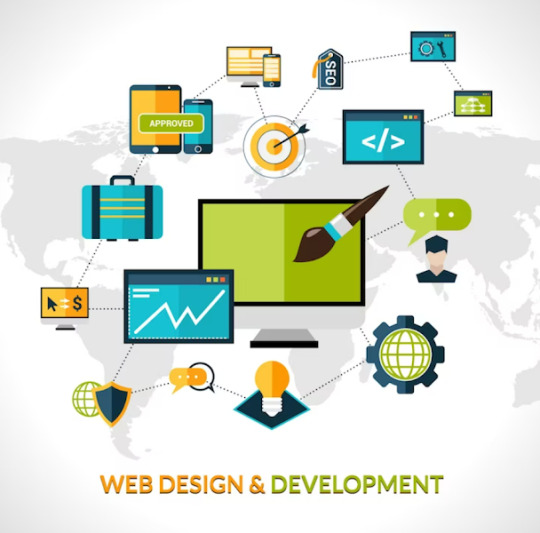
The Significance of Web Design and Development for Business Success
1 note
·
View note
Text
Our Professional Services At Trigma
Cloud: "Unlock the power of the cloud with our exceptional cloud services. Seamlessly scale your infrastructure, optimize performance, and ensure data security. Leverage the flexibility and cost-efficiency of the cloud to drive your business forward."
Web: "Experience the possibilities of the web with our dynamic web development services. From visually stunning designs to seamless user experiences, we create websites that captivate and engage. Let us bring your brand to life and elevate your online presence."
Mobile: "Stay ahead in the mobile era with our innovative mobile solutions. We build feature-rich, user-friendly mobile apps for iOS and Android, tailored to your specific needs. Empower your business, connect with users, and deliver exceptional mobile experiences."
Bubble: "Embrace the future of no-code development with our transformative bubble services. Rapidly build and deploy fully functional web and mobile applications without coding. Unleash your creativity, accelerate development cycles, and bring your ideas to life with ease.

#CloudSolutions#Scalability#DataSecurity#CostEfficiency#WebDevelopment#UserExperience#Design#OnlinePresence#MobileApps#Innovation#UserFriendly#iOSAndroid#Trigma
1 note
·
View note
Photo

“Do something today that your future self will thank you for.”
1 note
·
View note
Photo

" IF YOU BELIEVE in yourself enough and know what you want, You're Gonna Make It Happen. "
2 notes
·
View notes
Photo

“Stand up, be bold, be strong. Take the whole responsibility on your own shoulders, and know that you are the creator of your own destiny..” ― Swami Vivekananda
2 notes
·
View notes
Text
Why startups fail to take off after the initial buzz

Image courtesy: Reuters/Thomas Peter
The recently concluded Startup India event held in Delhi was proof enough that the startup boom is here to stay. A number of brilliant ideas have been converted into successful ventures across all segments, from technology and healthcare to retail, food services, etc. Backed by angel investors who are ready to fund unique ideas youngsters, fresh out of college, have left lucrative job offers to set up their own ventures. However, in the midst of all many successful stories are cases where startups have failed within three years of their being set up.
It can be heartbreaking to see a venture, where one has spent countless sleepless nights nurturing it, fail, but it is also important to find out why the idea may not have taken off. Some of these founders have learnt from their mistakes and have gone on to set up ventures that are successful. Here we take a look at some of the reasons why startups fail to succeed:
Lack of funding: One of the primary reasons why startups fail is quite obvious – lack of funding, or not correctly anticipating what the required investment amount would be. Food based e-commerce is one area which saw a number of startups coming up, but one that also saw a large number of failures, primarily because of their inability to raise funds. Chennai based OrderSnack, Bangalore based Dazo, Delhi based Langhar are all startups that shut down last year because of their inability to raise funds. Food tech startups Tiny Owl and Zomato have also been cutting down on their staff, with Zomato shutting down its online ordering services in four cities.
Being ahead of its time: A few startups have even failed because the ideas on which they were founded were much ahead of their time, and the market was not mature enough to accept them. Take the case of online grocery stores - while some may be willing to buy vegetables online, most Indians still want to touch and feel the vegetable that they are buying – hence making it an interesting idea, but one that people may not be ready for as of yet. An example is that of online grocery delivery firm Localbanya, which shut down temporarily, and had also scaled down its employee strength. Another startup, Guruji, a Sequoia Capital funded startup founded by IIT graduates Anurag Dod and Gaurav Mishra, which started in 2007 as a national search engine in the lines of Google for Indians, shut down. Guruji also served content provided by music piracy websites such as songs.pk, musicplug.in, bollymobile.in, etc. In 2010, the top officials of Guruji were arrested over charges of alleged music piracy made by T-Series. The idea was interesting, but the market was not ready to accept it.
An overcrowded market: Survival of the fittest is the key in any business, especially in an already overcrowded market. Hence, a number of startups fail because they are unable to withstand the competition in the space that they are in. E-commerce is one segment that has seen a huge number of startups, and many have shut shop soon after launching. Unless the player has a niche advantage, or is heavily funded, it becomes really difficult to survive in the space. Gurgaon based women’s fashion startup DoneByNone, founded by Amarinder Dhaliwal, Vijesh Sharma, and Vijay Misra, experienced professionals in areas such e-commerce, internet businesses, and technology, failed because it was in an already crowded market and was unable to deliver on its promises. Another e-commerce website, Virtuplus, which dealt in niche products, had to be shut down as it could not withstand the competition.
Not having the proper team: A good team is vital in any set up, especially in the case of a startup. The core idea of the startup has to be clear to everyone in the team, and dedication to work against challenges and constraints is a must. The founder and the co-founder, along with the rest of the team have to be on the same page - differences between the founding members can affect the performance of the entire venture. One of the main reasons why Oravel Stays, the predecessor to Oyo Rooms founded by Ritesh Agarwal failed was because a proper team was not in place, leading to arguments. Agarwal learnt from his mistakes and went on to successfully launch Oyo Rooms.
Not clear about the idea: All startups are based on ideas, and that has to be clear before going about launching the firm. A lot of startups are launched because the founders like the idea, but are not users of the end product - hence do not know much about it. Some ideas may have sounded cool during discussions over a coffee, but may later turn out to be impractical. FTW, a website that sold wooden sunglasses and funky ones, founded by Siddhant Gupta, shut shop soon after opening. While the founders knew how to market their products, they did not know what went into the construction of these sunglasses - hence underestimating the cost factor.
Losing steam: Setting up a venture based on an interesting idea may sound romantic and fun initially, but it requires a lot of hard work and the ability to accept and overcome hurdles. Some set up their ventures as a part time project and without realising how much work actually goes into it. The result - the founders run out of steam and the venture sizzles out.
Single founder startups: Startups that are founded by a single person are at a higher risk of failing. That is because, with more brains come more and better ideas. Also, a reason why a startup would have been setup by a single person could be because no one else has faith in the idea, and hence, is unwilling to join - making the idea a bad one to start off with. Also, while going through a low period, which is bound to happen with any venture, it is always better to have others to support you and help you pull through it - a spirit of togetherness. But, this may also work in another way - differences between founders that lead to a breakup.
4 notes
·
View notes
Link
Once your startup takes off, one of the big challenges you’re going to face is finding a talented Growth Hacker and capable of driving its growth. Startup marketing is very different to traditional marketing, and thus you’ll need to take a slightly different approach. Here are some tips on how to hire a skilled growth hacker.
2 notes
·
View notes